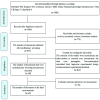Evaluating the effectiveness of six exercise interventions for low back pain: a systematic review and meta-analysis
- PMID: 40312680
- PMCID: PMC12045001
- DOI: 10.1186/s12891-025-08658-0
Evaluating the effectiveness of six exercise interventions for low back pain: a systematic review and meta-analysis
Abstract
Objective: To validate the effectiveness of six exercise therapies in treating low back pain using Meta-analysis methods, and to propose optimal exercise duration, frequency, and cycle.
Methods: Databases such as PubMed, EMBASE, Cochrane Library, China National Knowledge Infrastructure, VIP Data, and SinoMed were searched. The RevMan 5.4 tool was utilized to conduct subgroup analyses on eight moderating variables, including types of exercise, duration, frequency, cycle, sample size, study quality, outcome indicator, and comparisons of different intervention methods with the control group from 42 included studies. Random effects models were employed to test for overall effects, heterogeneity, and bias.
Results: The overall effect size for six exercise therapies for low back pain was significant (SMD= -1.21, P < 0.00001). Subgroup analyses showed yoga had the largest effect (SMD= -1.97, P = 0.0001). Exercise duration ≤ 30 min (SMD= -1.31, P < 0.0001), frequencies > 4 times/week (SMD= -1.56, P < 0.00001), and cycles ≤ 4 weeks (SMD= -1.61, P < 0.00001) were most effective. Sample sizes of 30~60 cases (SMD= -1.36, P < 0.00001) and studies with moderate bias risk (SMD= -1.37, P < 0.00001) also showed large effects. The Oswestry Disability Index scores demonstrated the most significant effect size (SMD= -3.35, P < 0.00001). The effect size of the physical factors in the control group was the largest (SMD= -1.85, P < 0.00001).
Conclusion: All six exercise therapies effectively alleviated low back pain, with yoga showing the best results. The optimal exercise intervention protocol involved exercise duration not exceeding 30 min per session, frequency of more than 4 times per week, and cycle not exceeding 4 weeks. Additionally, exercise interventions exhibited the most significant improvements in Oswestry Disability Index scores for low back pain.
Keywords: Effect size; Exercise intervention; Low back pain; Meta-analysis; Randomized controlled trial.
© 2025. The Author(s).
Conflict of interest statement
Declarations. Ethics approval and consent to participate: Not applicable. Consent for publication: Not applicable. Competing interests: The authors declare no competing interests.
Figures





Similar articles
-
Yoga compared to non-exercise or physical therapy exercise on pain, disability, and quality of life for patients with chronic low back pain: A systematic review and meta-analysis of randomized controlled trials.PLoS One. 2020 Sep 1;15(9):e0238544. doi: 10.1371/journal.pone.0238544. eCollection 2020. PLoS One. 2020. PMID: 32870936 Free PMC article.
-
Yoga Treatment for Chronic Non-Specific Low Back Pain (2017).Explore (NY). 2017 Jul-Aug;13(4):281-284. doi: 10.1016/j.explore.2017.04.018. Epub 2017 Apr 22. Explore (NY). 2017. PMID: 28688789
-
Effects of yoga on patients with chronic nonspecific neck pain: A PRISMA systematic review and meta-analysis.Medicine (Baltimore). 2019 Feb;98(8):e14649. doi: 10.1097/MD.0000000000014649. Medicine (Baltimore). 2019. PMID: 30813206 Free PMC article.
-
The Effects of Exercise on Inhibitory Function Interventions for Patients With Major Depressive Disorder (MDD): A Systematic Review and Meta-Analysis.Brain Behav. 2025 Jan;15(1):e70178. doi: 10.1002/brb3.70178. Brain Behav. 2025. PMID: 39739535 Free PMC article.
-
Exercise prescription for improving chronic low back pain in adults: a network meta-analysis.Front Public Health. 2025 May 30;13:1512450. doi: 10.3389/fpubh.2025.1512450. eCollection 2025. Front Public Health. 2025. PMID: 40520315 Free PMC article.
References
-
- Urits I, Burshtein A, Sharma M et al. Low back pain, a comprehensive review: pathophysiology, diagnosis, and treatment [J].Curr Pain Headache Rep,2019,23.23. - PubMed
-
- Wirth, B. Schweinhardt P. Personalized assessment and management of non-specific low back pain [J]. Eur J Pain,2024,28.181-198. - PubMed
Publication types
MeSH terms
Grants and funding
LinkOut - more resources
Full Text Sources

